Ash plume heads to Pahala after rock falls, gas explosions in Halemaumau Crater

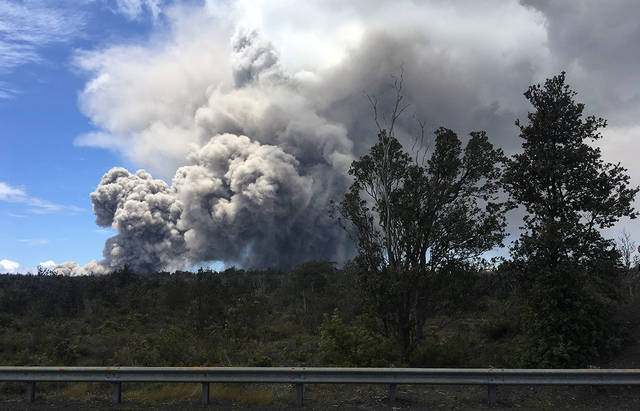
CINDY ELLEN RUSSELL / CRUSSELL@STARADVERTISER.COM
A plume of ash was seen today above Halemaumau crater on Hawaii island.
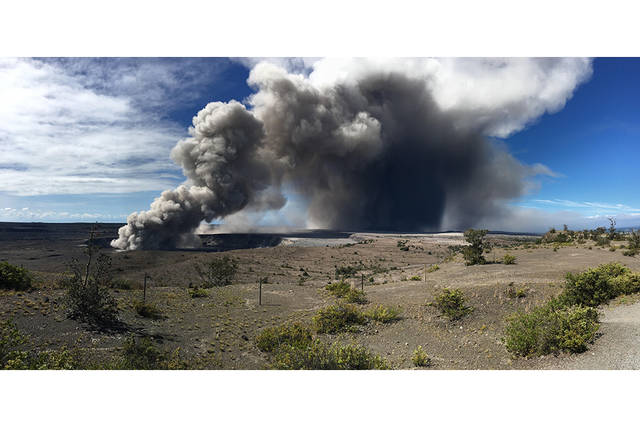
COURTESY USGS
Volcanic output at Halemaumau crater in Kilauea’s summit increased this morning to include the nearly continuous emission of ash with intermittent stronger pulses that form occasional higher plumes up to 6,000 feet above ground, scientists said. This U.S. Geological Survey photo shows the ash plume at about 9 a.m.
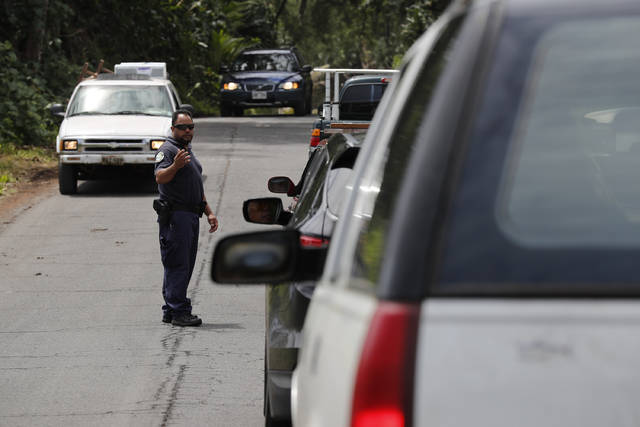
CINDY ELLEN RUSSELL / CRUSSELL@STARADVERTISER.COM
Signage informs motorists along Kahakai Blvd. of restricted access along Highway 137 (Beach Road).
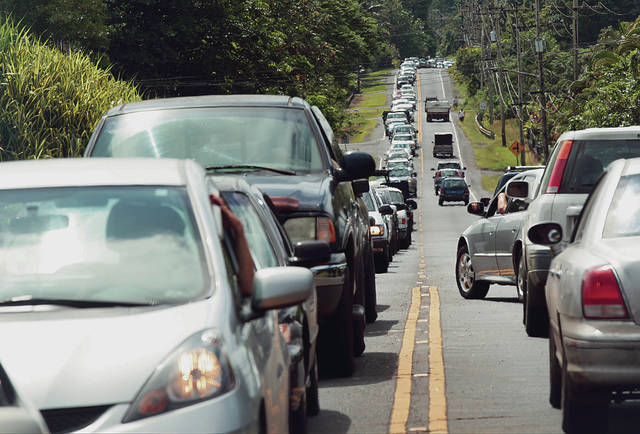
JAMM AQUINO / JAQUINO@STARADVERTISER.COM
Traffic is seen along Highway 132 as Leilani Estates residents wait to return to their homes to gather vital belongings and animals on May 6, in Pahoa, Hawaii island. With this key route now threaten by lava, state officials are trying to reopen the alternative route of Highway 130.
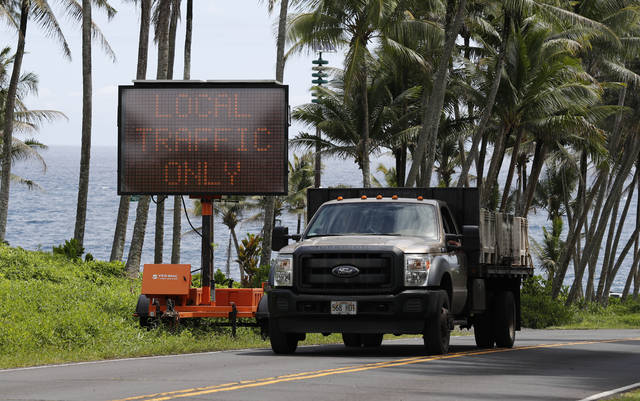
CINDY ELLEN RUSSELL / CRUSSELL@STARADVERTISER.COM
Signage informs motorists along Kahakai Blvd. of restricted access along Highway 137 (Beach Road).






UPDATE: 1 p.m.
Hawaiian Volcano Observatory scientists say the eruptive activity in Lower Puna remained concentrated at fissure 17, with intermittent lava spattering at fissure 18, today.
A new fissure, No. 20, near fissure 18 also produced two small pads of lava, they said early this afternoon. The lava flow from fissure 17 advanced about 1,250 ft since 2:30 p.m. Monday. The advance of the flow has slowed significantly since Monday afternoon, according to HVO.
Volcanic gas emissions remain elevated throughout the area downwind of the fissures, HVO warns.
Scientists said magma continues to be supplied to the lower East Rift Zone and elevated earthquake activity continues.
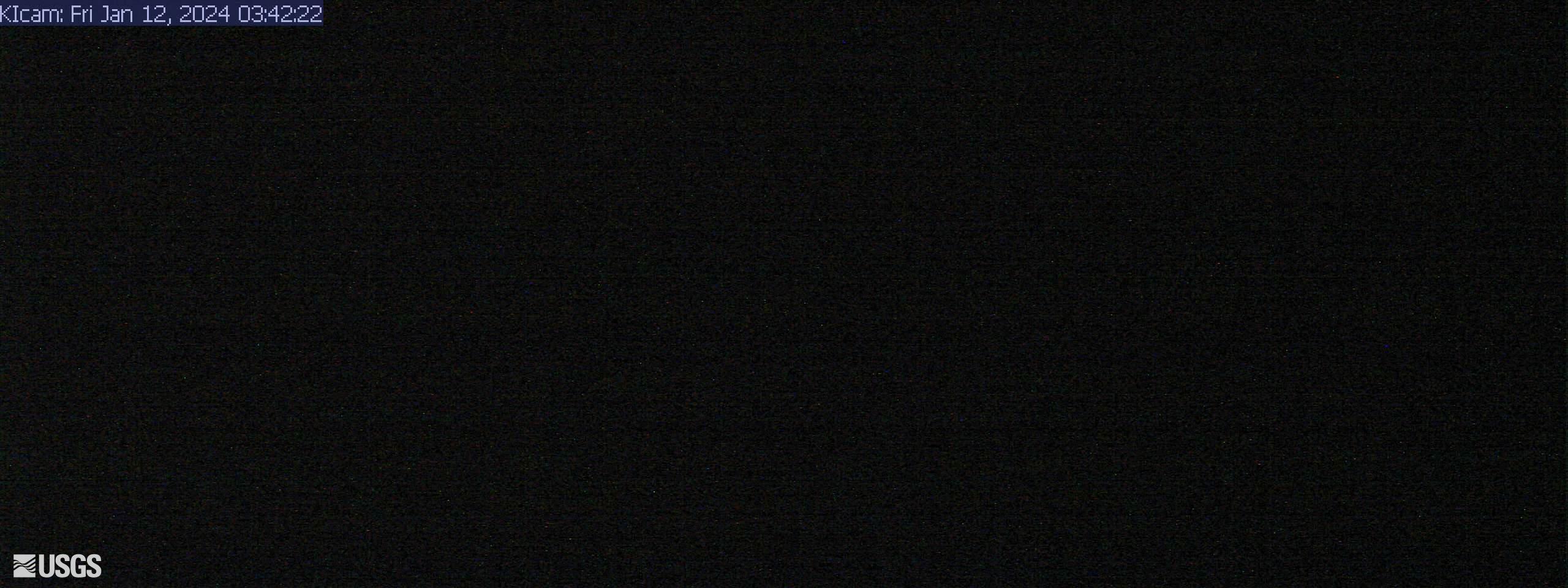
Don't miss out on what's happening!
Stay in touch with breaking news, as it happens, conveniently in your email inbox. It's FREE!
10:27 a.m.
The Hawaiian Volcano Observatory reports rock falls and gas explosions within Halemaumau Crater.
An ash plume is traveling downstream across the Ka’u district along Highway 11 to Pahala. Motorists are advised to drive with caution.
10 a.m.
Volcanic ash emission from the Overlook crater within Halemaumau has increased this morning compared to previous days, with a gray cloud rising up to 4,000 feet above ground, according to the Hawaiian Volcano Observatory.
“The ash cloud is drifting generally west and southwest from the Kilauea summit and ashfall is occurring in the Ka’u Desert,” the HVO said in an alert. “Communities downwind are likely to receive ashfall today and should take necessary precautions.”
8:30 a.m.
The state Department of Transportation is reopening Highway 130 from Malama Street to Kamaili Road to local traffic after an inspection today showed the roadway is currently safe. However, the highway may be shut down again if hazardous conditions develop.
The Hawaiian Volcano Observatory, meanwhile, said the plume coming from inside Halemaumau crater is “steady and gray due to its ash content. The plume is rising several thousand feet above the ground and drifting to the southwest. Ashfall is occurring in the upper Kau Desert and downwind.” HVO officials said that dustings of ash may occur in the summit area and downwind.
>> LIVE: Webcam images from Halemaumau at Kilauea
>> Ash plume heads to Pahala after rock falls, gas explosions in Halemaumau Crater
>> Escape road threatened, geothermal wells to be killed as lava approaches
>> Officials seek to shore up Pahoa lifelines, Mayor Kim says
>> Tourism losses mount across the Big Island
>> Evacuees get a brief respite from Kilauea’s eruption
>> Video: Gov. David Ige gives May 14 Kilauea update
>> Photos: Residents prepare for the worst as more fissures open
>> Photos: Tourists stay despite eruption threats from Kilauea
COMPLETE KILAUEA COVERAGE
Star-Advertiser volcano coverage
Kilauea Volcano YouTube playlist
7:55 a.m.
Some communities on Hawaii island will likely see a light ashfall from Kilauea Volcano today.
The webcam at Kilauea volcano summit showed a burst in volcanic ash emissions from Halemaumau crater around 7 a.m. today, according to the National Weather Service.
Northeast winds will carry ash downstream across Hawaii island, affecting the Punaluu, Wood Valley and Naalehu communities in the Kau District this morning and into early afternoon, weather officials said.
The air quality in Pahala this morning has been measured as “unhealthy” and is decreasing, according to the University of Hawaii’s Vog Measurement and Prediction Project Opens in a new tab.
“Avoid excessive exposure to ash which is an eye and respiratory irritant,” the weather service said in an alert. “Those with respiratory sensitivities should take extra precaution to minimize exposure.”
6:30 a.m.
Geologists with the Hawaiian Volcano Observatory have confirmed that a new fissure — the 20th — has opened in the Lanipuna Gardens subdivision northeast from fissure 19. Meanwhile, the narrow lava flow from fissure 17 is still moving slowly toward the ocean at about 20 yards an hour.
Because of the volcanic activity, Hawaii island residents and visitors are advised of the following:
>> The state Department of Transportation will not reopen the Highway 130 near Leilani Estates this morning due to new cracks in the pavement that developed overnight.
>> The Health Department reports hazardous emissions of sulfur dioxide gas from fissures are especially dangerous for elderly, children, babies and people with respiratory problems. SO2 can be carried by wind, or, cover an area with no wind.
4:30 a.m.
The narrow lava flow from fissure 17 continues to move at a slow pace toward the ocean but is not threatening any homes.
The air quality in the area of southeast Lanipuna Gardens and the nearby farm lots remains “condition red,” according to Hawaii County Civil Defense.
Highway 132 is closed at the intersection with Pohoiki Road and a checkpoint is located at Highway 130 by Pahoa High School. Authorities are only allowing local traffic beyond the roadblocks.
MONDAY, MAY 14
5:05 p.m.
Hawaii County Fire Department officials report high levels of sulfur dioxide in the southeast area of Lanipuna Gardens and surrounding farm lots. They say the air quality in the area is “condition red,” meaning it is an immediate danger to health.
“Leaving the area is the best course of action. Seek medical attention if severely affected,” said a county Civil Defense alert to the public issued late this afternoon.
The area has been under a mandatory evacuation order since the lava outbreak began on May 3.
4:15 p.m.
HILO >> Lava from Kilauea volcano has now reached within 1.3 miles of the coastal Highway 137, threatening one of the last evacuation routes in lower Puna.
However, scientists with the U.S. Geological Survey said at an afternoon briefing that the flow from fissure 17 has slowed, progressing only two-tenths of a mile in the last six hours. Earlier in the day, it had been progressing at about 100 yards an hour.
USGS officials said the active flow has been releasing jets of gases so loud that they could be heard over the sound of helicopter rotors as scientists flew over the area.
Also at the briefing, Tom Travis, administrator of the Hawaii Emergency Management Agency, said authorities are moving forward with a plan to kill the three active geothermal wells on the Puna Geothermal Venture site.
Travis said cold water will be pumped into the wells which will then be plugged with iron caps.
“Our way forward is to kill — and continue to kill — the wells,” he said. He said he expects that they will be pumping cold water into the wells as early Tuesday and Wednesday. The PGV plant, which had supplied an estimated 25 percent of the island’s energy, was shut down soon after the Leilani Estates lava outbreak began on May 3.
Travis said it is possible that the wells could be made functional again but that is “an issue for another a day.”’
2 p.m.
Hawaii County and state Department of Health officials are reminding the public that sulfur dioxide gas and other emissions produced by the Kilauea volcano eruption are hazardous, especially for elderly, young children and babies and people with respiratory problems.
“People who are downwind or close to the vents and lava flows are also at high risk,” a county advisory says. “Be aware of the unpredictable nature of dangerous levels of (sulfur dioxide) gas because it can be carried far from the fissures with wind speed and direction.”
Officials recommend that when vog levels are elevated, residents should:
>> Leaving the area of volcanic activity or shelter in place.
>> Avoid outdoor activities that cause heavy breathing.
>> Drink plenty of fluids to avoid dehydration.
>> Avoid smoking and second-hand smoke.
>> Stay indoors and close windows and doors prior to gas inundation.
>> If an air conditioner is used, set it to recirculate.
>> Keep medications on hand and readily available.
>> Daily prescribed medications, should be taken on schedule and may provide relief from the effects of sulfur dioxide.
>> Contact a doctor as soon as possible if any health problems develop.
The public can monitor vog levels and forecasts by visiting: https://vog.ivhhn.org Opens in a new tab.
11:15 a.m.
The National Weather Service this morning issued an alert for residents of southern areas of the Big Island warning that “very light ashfall is expected through at least 6 p.m.” today.
The ash is coming from Halemaumau Crater on the Kilauea volcano’s summit which “showed a burst in volcanic emissions at around 9 a.m.” today which was visible via satellite and web cameras.
“Satellite shows northeast winds carrying volcanic ash downstream across the Big Island Kau District and was observed on the Punaluu area shortly after the burst. Volcanic ashfall will be possible through the rest of the day across the Kau District,” the NWS special weather statement said.
Officials advise people in the affected area to avoid excessive exposure to ash which can irritate the eyes and respiratory systems.
“Those with respiratory sensitivities should take extra precaution to minimize exposure,” officials said.
Geologists with the Hawaiian Volcano Observatory are watching the summit crater for a possible explosive steam-driven eruption of ash and rock as the crater’s lava lake falls below the water table.
PREVIOUS COVERAGE
HILO >> The state is moving ahead with plans to use prefabricated concrete slabs or other materials to construct a bridge to reopen Highway 130 into the Kalapana area, a route that was closed nearly a week ago because of four-inch cracks in the pavement.
The announcement this morning by Gov. David Ige comes as lava is creeping closer to Highway 132, a smaller highway that is one of the last evacuation routes left out of Lower Puna.
>> RELATED VIDEO: Gov. David Ige Gives Kilauea Volcano Update (mobile app users, click here Opens in a new tab)
County spokeswoman Jane Snyder said today that lava from fissures northeast of Leilani Estates subdivision has been expanding by 150 to 200 yards an hour, posing a possible threat to Highway 132, which has become an important route out of the area for local residents who still haven’t evacuated.
“This is the first real flow that we’ve had, and they think it involves new lava because it’s flowing, it’s more fluid,” Snyder said.
Up until now scientists believe most or all of the lava that has reached the surface was “old” lava from a 1955 eruption that was stored in underground reservoirs. That old lava is now being pushed to the surface as new lava is injected into the Lower East Rift Zone through some sort of newly opened underground plumbing system that extends into the East Rift area.
Scientists expected that once the newer lava reaches the surface, it would likely be more hot and less pasty that the older lava, and would therefore flow more freely and quickly once it emerges.
Snyder said she does not know how close the current flow is the Highway 132, which extends from the “Four Corners” area to Pahoa.
Ige said this morning he has authorized funding to ship specialized equipment from the mainland to secure the geothermal wells at the closed Puna Geothermal Venture power plant near where a 19th fissure opened in the Lanipuna Gardens area this morning. Ige told reporters at the county Civil Defense headquarters today he is unsure if that equipment has been shipped yet.
With Kilauea volcano opening new fissures daily, the state is hurrying to make improvements to potential evacuation routes. Ed Sniffen, deputy director of the state Department of Transportation, said reopening Highway 130 is now a top priority for the department.
State officials announced on May 7 that Highway 130 was closed between Pahoa and Old Kalapana Road because of widening cracks in road at mile markers 14.4 and 14.6.
That highway had been the highest capacity route in and out of the Kalapana area, serving the communities of Kaimu, Opihikao, and the Seaview Estates and Black Sand Beach subdivisions.
The closure of Highway 130 prompted state crews to drop gravel and make other improvements to Highway 137, a partially paved coastal road that could serve as another emergency route out of lower Puna.
This morning scientists with the U.S. Geological Survey reported lava from fissures 17 and 18 was moving closer to Highway 132, which connects the coastal areas with the subdivisions of Leilani Estates and Lanipuna Gardens. Lava has already entered both of those subdivisions, and has so far destroyed 37 structures.
“Now that we see the risk extending towards (Highway) 137, if that gets cut off, then the route has got to go back to (Highway) 130 again,” Sniffen said in an interview this morning. “So, we’re looking at options to minimize any risk as 130.”
In the near term, the state may drop metal plates other the cracks in Highway 130, which are believed to have been opened by forces related to the ongoing eruption, he said. The state would also install a monitoring system involving senors or cameras so the state can quickly close the road quickly if it deteriorates further, Sniffen said.
“On the route itself, we know that those fissures could become active, and when they do, we’ve got to have something in place to ensure that when it does become active, that people can traverse it safely,” he said.
One possibility is to use prefabricated concrete slabs that can resist heat of up to 2,000 degrees to build a bridge over any hazard that threatens Highways 130 or 137. Another possibility would be to reopen Chain of Craters Road leading to the Hawaii Volcanoes National Park, he said.
Chain of Craters Road has been repeatedly severed by lava flows that traveled from the Puu Oo crater area to the sea, but the county did reopen it for a time in 2014 to provide an emergency access when another lava flow threatened Highway 130 near Pahoa.
Sniffen said he does not get have a specific date when construction will start, but “what we want to do is open 130 as soon as possible to local traffic.”
>> RELATED VIDEO: USGS Kilauea Volcano Status Update, May 14 (mobile app users, click here Opens in a new tab)




